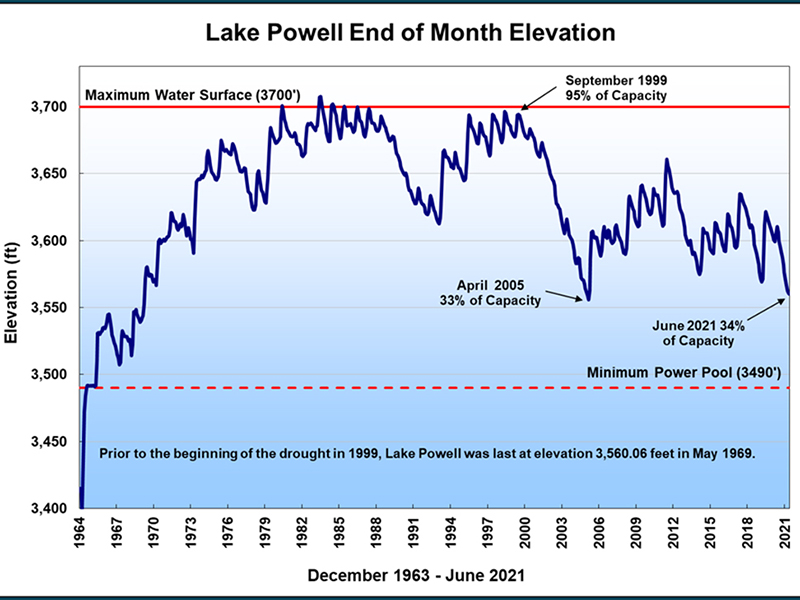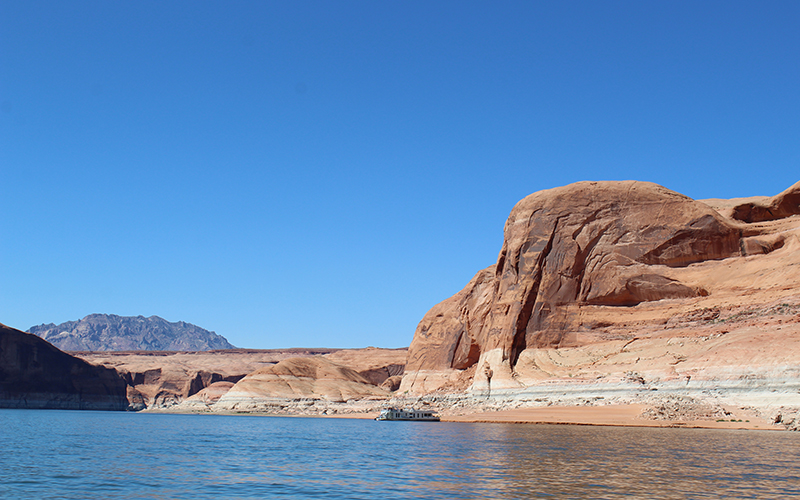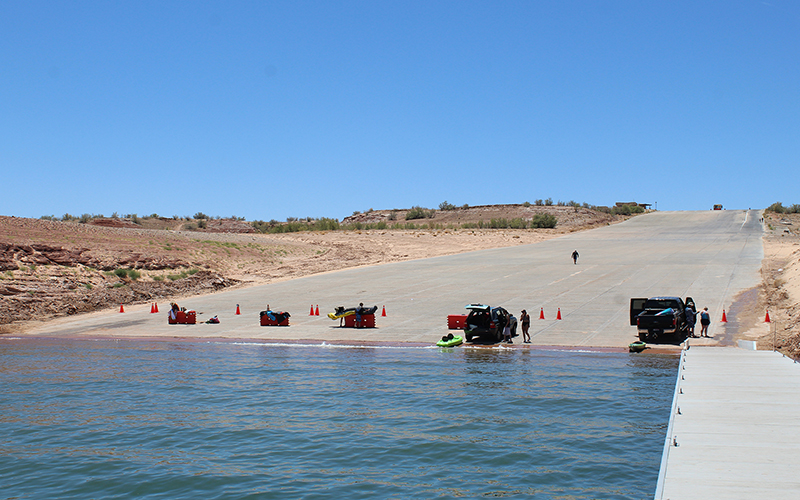The nation’s second-largest reservoir, Lake Powell, is now at its lowest point since it filled in the 1960s.
The massive reservoir on the Colorado River hit a new historic low Saturday, dropping below 3,555.1 feet in elevation. The previous low was set in 2005. The last time the reservoir was this low was in 1969, when it first filled. It’s currently at 33% of its capacity.
The popular recreation hotspot on the Arizona-Utah line, which plays host to houseboats, kayaks and speedboats, has fluctuated over the past 21 years because of low river flows exacerbated by rising temperatures. About 4.4 million people visited Lake Powell in 2019, and spent $427 million in nearby communities, according to the National Park Service.
Demand for water across the seven U.S. states and two Mexican states that rely on the Colorado River has not declined fast enough to match the reduced supply, said Brad Udall, a climate scientist at Colorado State University.
“Basically every drop in the river is being utilized. And so everyone wants a piece of this river and there’s nothing left over,” Udall said. (Some of Udall’s work receives funding from the Walton Family Foundation, which also supports KUNC’s Colorado River coverage.)

The level of Lake Powell, measured in feet above sea level, is now at its lowest point since the reservoir behing Glen Canyon Dam first filled in the late 1960s. (Chart courtesy Bureau of Reclamation)
Forecasts for Lake Powell’s inflows from the Colorado River grew increasingly pessimistic during spring and early summer this year. Flows from April to July are projected to be at 25% of the long-term average, putting 2021 into the top three driest on record for the watershed.
“The hard lesson we’re learning about climate change is that it’s not a gradual, slow descent to a new state of affairs,” Udall said.
Emergency water releases from smaller reservoirs upstream of Lake Powell will take place over the next six months, in hopes of maintaining hydropower production at the Glen Canyon Dam that created the lake.
“I’m very alarmed,” said Tanya Trujillo, assistant secretary for water and science at the Interior Department. “It’s not only focused on hydropower concerns, we’re concerned operationally in general. We’re acting in coordination with the states about these decisions.”
Lake Mead, the nation’s largest reservoir, is also on the Colorado River and is also at a record low. Water levels in both lakes are projected to decline further this year. The reservoirs are part of a water delivery system on which more than 40 million people rely.
Lake Mead’s decline will for the first time trigger an official federal shortage declaration.
“The fact that we’ve reached this new record underscores the difficult situation that we’re in,” said Wayne Pullan, Upper Colorado River regional director for the Bureau of Reclamation.
The river’s current managing guidelines are set to expire in 2026. An update to those guidelines passed in 2019 included a potential demand management program in the river’s Upper Basin states of Colorado, Wyoming, Utah and New Mexico.
In concept, the program would pay water users to voluntarily forgo water deliveries in exchange for payment. The saved water could be banked in Lake Powell to buffer against a potential Colorado River Compact call from downstream states.
But none of the Upper Basin states has committed to fully implementing a plan to rein in demands on the river’s water in order to fill Lake Powell with conserved water. The plan remains in an investigatory phase.
“That is one potential solution, or piece of a solution,” said Rebecca Mitchell, Colorado’s representative on the Upper Colorado River Commission. “This has put a sense of urgency in the work that we’re doing at the state level. And we’re going to continue to push forward as much as we can on that.”
-This story is part of ongoing coverage of the Colorado River, produced by KUNC, and supported by the Walton Family Foundation.

